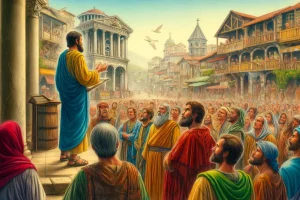
The Book of Jonah
The Book of Jonah is a unique and intriguing narrative within the collection of the Twelve Minor Prophets in the Hebrew Bible. Here are some quick facts about this book:
- Authorship and Date: The author of the Book of Jonah is unknown, and the text is traditionally dated to the early post-exilic period, around the 5th century BCE.
- Historical Setting: The narrative concerns Jonah, the son of Amittai, mentioned in 2 Kings as a prophet from the northern kingdom of Israel during the reign of Jeroboam II (8th century BCE).
- Structure: The book is brief, comprising just four chapters. It narrates Jonah’s mission to Nineveh, his initial flight, his encounter with a great fish, his subsequent prophetic warning to Nineveh, and his reaction to Nineveh’s repentance.
- Themes:
- Divine Mercy and Compassion: Explores the theme of God’s mercy, emphasizing His willingness to forgive even the enemies of Israel if they repent.
- Human Obstinacy vs. Divine Patience: Illustrates the contrast between Jonah’s reluctance and God’s patience.
- Universalism of God’s Message: Jonah’s mission to the Assyrian city of Nineveh underscores the universal scope of God’s concern and message.
- Key Episodes:
- Jonah in the Belly of the Fish: A symbolically rich episode where Jonah spends three days and nights in the belly of a great fish before being vomited out, symbolizing rebirth and repentance.
- Nineveh’s Repentance: The city’s unexpected repentance serves as a lesson in humility and divine grace.
- Literary Features: The book combines elements of satire, allegory, and parable, particularly highlighting Jonah’s flawed character in contrast to the earnest repentance of the Ninevites and even the responsiveness of the natural world.
- Theological Significance: Challenges conventional prophetic themes by focusing on God’s mercy over judgment and the inclusivity of His compassion.
The Book of Jonah stands out among the prophetic books of the Hebrew Bible due to its narrative style and its focus on the prophet’s character and personal transformation rather than on direct oracles against Israel or other nations. Here is a detailed analysis of the Book of Jonah, examining its structure, themes, and broader theological messages.
1. Historical and Literary Context
Though set in the historical context of the 8th century BCE, most scholars agree that the Book of Jonah was written in the post-exilic period, around the 5th century BCE. Unlike other prophetic texts that primarily address Israel or Judah, Jonah is directed towards the Assyrian city of Nineveh, making it unique in its universal outlook.
2. Structure
The book comprises four chapters, each marking a distinct phase in Jonah’s journey:
- Chapter 1: Jonah’s call to prophesy against Nineveh and his subsequent attempt to flee from God’s command by sailing to Tarshish.
- Chapter 2: After being swallowed by a great fish, Jonah prays to God from the belly of the fish and is eventually delivered.
- Chapter 3: Jonah finally goes to Nineveh and delivers God’s warning; the city repents, leading to God sparing it from destruction.
- Chapter 4: Jonah’s anger at God’s mercy towards Nineveh and the lesson taught by God using a plant and a worm.
3. Major Themes
- Divine Mercy and Forgiveness: Central to the book is the theme of God’s overwhelming mercy, extending even to Nineveh, Israel’s enemy. This challenges parochial views of God’s grace being exclusive to Israel.
- Human Obstinacy: Jonah’s resistance is stark against the backdrop of Nineveh’s readiness to repent. His reluctance and narrow-mindedness contrast with God’s expansive compassion.
- The Universal Scope of God’s Concern: God’s care extends beyond Israel to all creation, including foreign nations and even animals, as highlighted in God’s closing remarks concerning Nineveh’s “more than 120,000 persons… and also much cattle.”
4. Literary Features
Jonah is rich in irony and satire—Jonah, the prophet, is less compliant to God’s will than the pagan sailors and the Ninevites. The narrative also uses hyperbole, such as the description of Nineveh’s size and the exaggerated readiness of its inhabitants and animals to repent.
5. Theological Implications
The Book of Jonah poses deep questions about the nature of God and the scope of divine mercy. It portrays God as patient and teaching, using Jonah’s experiences to reflect on themes of repentance, obedience, and the righteousness of divine mercy.
- God as Educator: The narrative closes with God teaching Jonah about compassion, reflecting a divine pedagogy that is patient and instructive rather than merely punitive.
- Repentance and Change: Nineveh’s transformation shows that repentance is always possible and can avert disaster, a hopeful message that underscores the potential for redemption.
6. Contemporary Relevance
Jonah’s story resonates in modern contexts where themes of inclusivity, divine justice, and mercy continue to challenge and inspire. It serves as a reminder of the need for empathy and the universal availability of God’s grace.
In conclusion, the Book of Jonah offers a profound exploration of divine-human interaction, emphasizing mercy over judgment and universal love over nationalistic pride. It serves not only as a religious text but also as a moral and philosophical treatise on the nature of compassion and the responsibilities of those who serve as intermediaries between the divine and the human.
Tag:Assyrian empire, divine compassion, divine mercy, divine patience, forgiveness, GPT Jonah, grace, great fish, Hebrew Bible, human obstinacy, inclusivity, irony, Jonah's prayer, minor prophets, moral lessons, narrative prophecy, Nineveh, obedience, Old Testament, prophetic narrative, repentance, satire, theological implications, universalism



